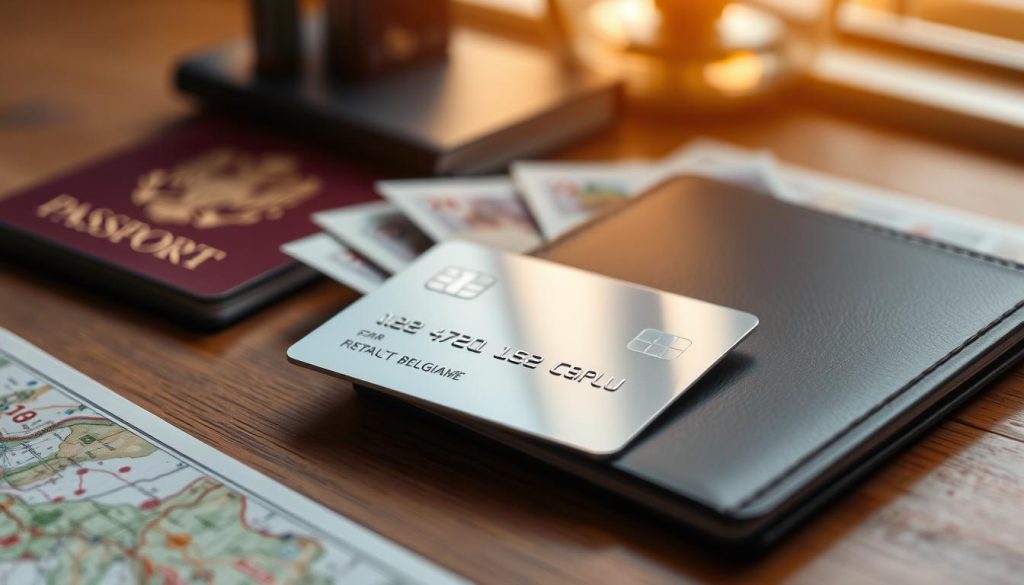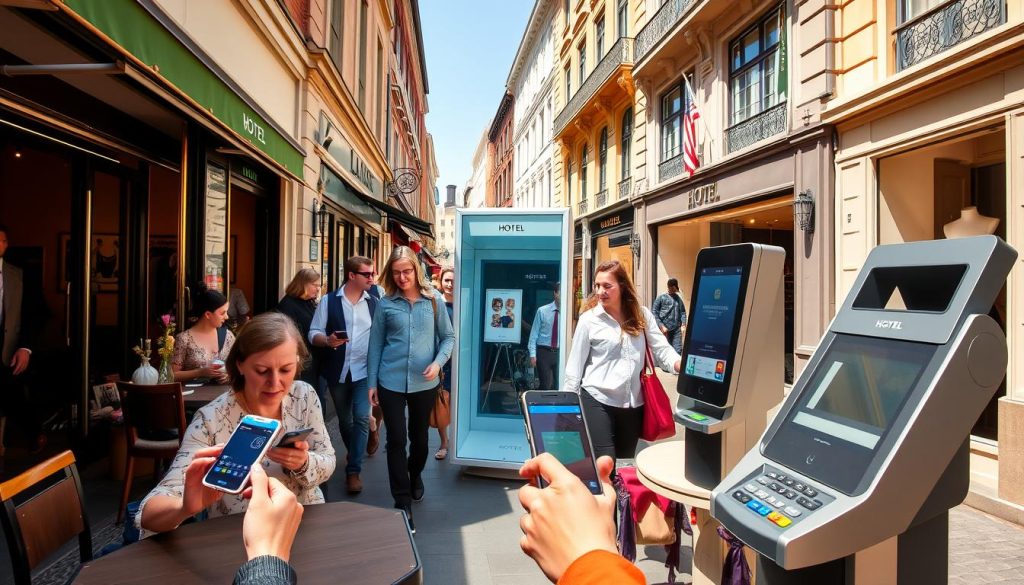Did you know that over 1.5 million U.S. tourists visit Belgium each year? With such a high number of visitors, understanding the local currency and payment methods is crucial for a smooth trip.
Belgium uses the Euro (€) as its official currency. This means you’ll need to exchange your dollars for euros before or during your visit. Monitoring live mid-market exchange rates can help you get the best value for your money. For example, the current rate is approximately 1 USD = 0.9258 EUR.
When it comes to payments, using a travel debit card or credit card from providers like Wise or Revolut can save you from unnecessary fees. These cards offer competitive conversion rates and are widely accepted across the country.
Planning ahead ensures you avoid high fees at airport exchange counters and unsafe currency exchange options. This guide will help you navigate payment methods, from restaurants to hotels, making your trip hassle-free.
Overview of Currencies & Payment Options in Belgium
Navigating payment options in a new country can be tricky, but it doesn’t have to be. Whether you prefer using cash or cards, understanding your choices ensures a smooth experience. This section breaks down the most popular methods and where to exchange your money.
Popular Payment Methods
In most places, you’ll find that debit and credit cards are widely accepted. Many shops, restaurants, and hotels support contactless payments, making transactions quick and easy. Travel cards from providers like Wise or Revolut are especially handy, offering low fees and transparent exchange rates.
For smaller purchases, having some cash on hand is useful. ATMs are plentiful in cities, allowing you to withdraw euros as needed. Always notify your bank before traveling to avoid card locks due to suspected fraud.
Currency Exchange Venues
When exchanging money, local venues in city centers often provide better rates than airport services. Avoid places that advertise “0 fees” or “no commission,” as these can be misleading. Instead, compare rates and check live mid-market exchange rates to get the best deal.
Here’s a quick comparison of popular exchange options:
| Option | Pros | Cons |
|---|---|---|
| Local Exchange Venues | Better rates, convenient locations | May require research to find reliable providers |
| Airport Exchange Counters | Immediate access upon arrival | Higher fees, less favorable rates |
| ATMs | Widely available, competitive rates | Potential withdrawal fees |
By planning ahead and choosing the right payment methods, you can save money and enjoy a hassle-free trip. Always double-check exchange rates and fees to make the most of your travel budget.
Understanding the Euro: Currency Basics in Belgium
The Euro is the backbone of financial transactions across much of Europe, including Belgium. As the official currency, it simplifies travel and commerce, making it easier for you to manage your money. Whether you’re shopping, dining, or exploring, knowing how the Euro works can save you time and avoid unnecessary fees.

Euro Fundamentals
The Euro (€) is used by 19 of the 27 European Union countries, including Belgium. It’s divided into 100 cents, with coins and banknotes available in various denominations. This standardization means you won’t need to exchange money when traveling between Eurozone countries.
Compared to your home currency, the Euro’s value fluctuates based on global market rates. For example, as of now, 1 USD equals approximately 0.9258 EUR. Understanding this rate helps you gauge how much your money is worth and plan your spending accordingly.
Live Exchange Rates Explained
Live mid-market exchange rates are the most accurate way to determine currency value. These rates reflect the real-time value of one currency against another, without markups or fees. For instance, if you see 1 USD = 0.9258 EUR, it means one US dollar can buy about 0.9258 euros.
Banks and currency exchange providers often add fees or offer less favorable rates. By using live rates, you can avoid these extra costs. Here’s a quick comparison:
| Option | Rate | Fees |
|---|---|---|
| Live Mid-Market Rate | 1 USD = 0.9258 EUR | None |
| Bank Exchange | 1 USD = 0.9100 EUR | 3-5% fee |
| Airport Exchange | 1 USD = 0.9000 EUR | High fees |
By keeping an eye on live rates, you can make smarter financial decisions while traveling. This knowledge ensures you get the most out of your money and enjoy a stress-free trip.
Benefits of Using Travel Debit & Credit Cards
Traveling abroad? A travel debit or credit card can make your journey smoother. These cards are designed to simplify international payments, offering convenience and savings. Whether you’re booking a hotel or dining at a restaurant, a travel card ensures you’re covered.
Why Choose a Travel Card
Travel cards provide access to competitive mid-market exchange rates. This means you get the fairest rate for your money, without hidden fees. Providers like Wise and Revolut are popular choices, offering low conversion costs and free ATM withdrawals.
Managing your finances is easier with mobile apps linked to your travel card. You can track spending, lock in exchange rates, and reload funds on the go. This level of control helps you stick to your budget while exploring new destinations.
Compared to carrying cash, travel cards are safer and more secure. If your card is lost or stolen, you can quickly block it through the app. Plus, you avoid the risk of losing large amounts of money.
- Low Fees: Avoid high foreign transaction fees with travel cards.
- Convenience: Use your card at hotels, restaurants, and shops worldwide.
- Security: Protect your funds with instant card blocking features.
For example, the Wise card allows you to hold money in over 40 currencies and spend in more than 150 countries. It’s a great option for frequent travelers who want flexibility and low costs.
By choosing the right travel card, you can save money and enjoy a stress-free trip. Make sure to compare providers and features to find the best fit for your needs.
Exchange Strategies: Converting USD to EUR
Planning your currency exchange strategy can save you money and stress during your trip. Whether you exchange your dollars before leaving or wait until arrival, understanding the pros and cons of each approach is essential.
Local vs. Pre-Trip Currency Exchange
Exchanging money before your trip might seem convenient, but it often comes with higher fees and less favorable rates. Many providers charge extra for pre-trip services, leaving you with fewer euros for your budget.
On the other hand, local exchange venues in city centers often offer better deals. These places are more competitive, giving you access to closer-to-mid-market rates. For example, the current rate is approximately 1 USD = 0.9258 EUR.
Airport exchange counters are another option, but they tend to have the highest markups. A good rule of thumb is to avoid them unless absolutely necessary. Instead, use ATMs or visit trusted local providers for better value.
Using Travel Cards for Automatic Conversion
One of the easiest ways to avoid extra fees is by using a travel debit card or credit card. These cards automatically convert your dollars to euros at competitive rates, saving you time and money.
Providers like Wise and Revolut are popular choices. They offer low conversion costs and free ATM withdrawals, making them ideal for travelers. Plus, you can track your spending and lock in rates through their mobile apps.
Practical Tips for Minimizing Costs
To get the most out of your money, always check the mid-market rate before making any exchange decisions. This rate reflects the real value of the currency without markups or fees.
Research local exchange providers before your trip. Look for reviews and compare rates to find the best deal. Planning ahead ensures you avoid unnecessary costs and enjoy a hassle-free experience.
Tips for Managing Money Abroad
Managing your money while traveling doesn’t have to be stressful if you know the right strategies. Hidden fees can quickly add up, but with a little planning, you can avoid unnecessary costs and keep your budget intact.
Minimizing Hidden Fees
One of the biggest challenges when using your card abroad is avoiding hidden fees. Many banks charge foreign transaction fees, which can range from 1% to 3% of each purchase. To save money, consider using a travel debit card or credit card with no foreign transaction fees. Providers like Wise and Revolut are excellent options.
When withdrawing cash from an ATM, stick to trusted bank networks. Some ATMs charge high fees, especially in tourist-heavy areas. For example, Barcelona charges €5 per transaction, while German banks like DB Deutsche often have no fees. Always verify fees before withdrawing.
Travel cards often offer fee-free withdrawals up to a monthly limit. This can save you significant amounts over time. Additionally, keeping a small amount of cash as backup ensures you’re covered in places that don’t accept cards.
Review your provider’s fee schedule before your trip. Look for foreign transaction fees, ATM surcharges, and dynamic currency conversion costs. Dynamic currency conversion, where the merchant converts your purchase into your home currency, can add an extra 5% to 10% to your bill. Always opt to pay in the local currency.
Finally, compare rates online using trusted currency conversion sites. This helps you get the best exchange rate and avoid unnecessary markups. By taking these steps, you can minimize fees and make the most of your travel budget.
Guide to Using Travel Money Cards in Belgium
Travel money cards are a smart way to handle your finances while exploring new destinations. They offer convenience, security, and cost savings, making them a popular choice for travelers. Whether you’re planning a short trip or a long adventure, these cards can simplify your payments and help you stay within budget.

How to Apply for Your Card
Applying for a travel money card is straightforward. Start by choosing a reliable provider like Wise or Revolut. Visit their website or download their app to begin the registration process. You’ll need to provide personal details, such as your name, address, and identification.
Once your identity is verified, you can order your physical or virtual card. Some providers charge a small fee for card delivery, but the benefits often outweigh the cost. For example, Wise charges a one-time fee of $9 for the first card, which arrives in 7-14 days.
Card Features and Fees
Travel money cards come with features designed to make your trip easier. Many support multiple currencies, allowing you to hold and spend money in euros, dollars, and more. Providers like Wise offer competitive mid-market exchange rates, saving you money on conversions.
Here’s a quick comparison of popular travel money cards:
| Provider | Key Features | Fees |
|---|---|---|
| Wise | 40+ currencies, free ATM withdrawals up to $6,000/month | $9 delivery fee |
| Revolut | 3 account plans, no-fee currency exchange | Varies by plan |
| Travelex | 10 currencies, no overseas ATM fees | 3.2% exchange markup |
Using a travel money card also enhances security. If your card is lost or stolen, you can quickly block it through the app. Plus, it’s not linked to your primary bank account, reducing the risk of fraud.
By choosing the right card, you can manage your funds seamlessly and enjoy a stress-free trip. Make sure to compare providers and features to find the best fit for your needs.
Belgium: Ultimate Travelers Guide to Currencies & Payments
Understanding how to handle your money in a foreign country can make your trip smoother. Whether you’re exploring bustling cities or quaint towns, knowing the best payment methods and exchange strategies ensures a stress-free experience.
One of the most important tips is to use live mid-market exchange rates. These rates give you the fairest value for your money, without hidden markups. For example, 1 USD equals approximately 0.9258 EUR. Always compare rates before exchanging your dollars to euros.
Using a travel debit card or credit card can save you from unnecessary fees. Providers like Wise and Revolut offer competitive rates and low conversion costs. These cards are widely accepted and provide added security compared to carrying large amounts of cash.
When it comes to exchanging money, local venues in city centers often offer better rates than airport counters. Avoid places with “0 fees” or “no commission” signs, as they may have hidden costs. Instead, research reliable providers and plan ahead to get the best deal.
Proper planning is key to avoiding fees and ensuring smooth transactions. By choosing the right payment methods and monitoring exchange rates, you can make the most of your travel budget. This guide is designed to help you navigate payments confidently during your trip.
Payment Options in Belgian Restaurants, Hotels, and Shops
When dining out or shopping in a new destination, knowing your payment options can make all the difference. Most establishments accept cards, making transactions quick and hassle-free. However, carrying a small amount of cash is still useful for tips or smaller purchases.

Contactless Payments: A Growing Trend
Contactless payments are widely accepted in restaurants, hotels, and shops. Using a travel debit card or credit card is convenient and secure. Many providers offer low fees and competitive exchange rates, saving you money on every transaction.
For example, Visa and Mastercard are accepted almost everywhere. This makes it easy to pay for meals, accommodations, and souvenirs without worrying about carrying large amounts of cash.
When Cash Comes in Handy
While cards are the norm, having some cash is essential for tipping or small purchases. In restaurants, it’s common to leave a small tip in cash, even if you pay the bill with a card. This ensures the service staff receives it directly.
In smaller shops or markets, some vendors may only accept cash. Always check with the establishment beforehand to avoid any surprises.
Travel Cards vs. Cash: What’s Better?
Using a travel debit card or credit card often saves you from high fees associated with currency exchange. Providers like Wise and Revolut offer transparent rates and low conversion costs. Plus, they’re safer than carrying large amounts of money.
On the other hand, cash is useful for immediate expenses like transportation or tips. A good rule of thumb is to carry a mix of both for flexibility.
Tipping Etiquette: Card or Cash?
In restaurants, it’s polite to leave a tip of around 5-10% of the bill. While you can add it to your card payment, leaving it in cash ensures it goes directly to the staff. For hotels, tipping porters or housekeeping in cash is also appreciated.
Always check the establishment’s requirements for tipping. Some places include a service charge, making additional tips unnecessary.
By understanding these payment options, you can navigate your trip with ease. Whether you prefer cards or cash, planning ahead ensures a smooth experience.
Leveraging ATMs and Local Exchange Providers
Accessing cash and finding reliable exchange services is essential for a smooth travel experience. Whether you’re withdrawing euros or exchanging dollars, knowing where to go and what to look for can save you time and money.
Finding Reliable ATM Networks
Using ATMs is one of the easiest ways to get cash while traveling. Look for machines located in secure areas, such as banks or busy streets. Avoid standalone ATMs in quiet or poorly lit places, as they may be more vulnerable to skimming devices.
Before using an ATM, check for visible security measures like cameras or tamper-proof card slots. Notify your bank about your travel plans to avoid card blocks. Many banks also partner with international networks, allowing you to withdraw cash with lower fees.
Choosing Local Exchange Providers
When exchanging money, local providers often offer better rates than airport counters. Research reputable exchange offices in city centers or near tourist hotspots. Avoid places with flashy “0 fees” signs, as they may have hidden costs.
Compare rates online using live mid-market exchange rates. This ensures you get the fairest value for your money. For example, 1 USD equals approximately 0.9258 EUR, so always double-check the rate before exchanging.
Benefits of Travel Cards
Using a travel debit card or credit card can simplify your transactions. These cards automatically adjust to local ATM networks, saving you from high fees. Providers like Wise and Revolut offer competitive rates and fee-free withdrawals up to a monthly limit.
Travel cards also enhance security. If your card is lost or stolen, you can quickly block it through the app. Plus, they’re not linked to your primary bank account, reducing the risk of fraud.
Planning Your Cash Needs
Before your trip, map out trusted ATM locations and exchange providers. This helps you avoid last-minute searches and unnecessary fees. Keep a small amount of cash for immediate expenses, but rely on your card for larger purchases.
By planning ahead and choosing the right payment methods, you can enjoy a hassle-free travel experience. Always review fee schedules and withdrawal limits to make the most of your money.
Safety and Security Tips for Financial Transactions in Belgium
Ensuring the safety of your financial transactions is a key part of any travel plan. While exploring new destinations, it’s important to stay vigilant and protect your money and personal data. Here are some essential tips to help you navigate financial security with confidence.
Avoiding Fraudulent Schemes
Scams targeting travelers are unfortunately common. Be cautious of unsolicited offers or individuals asking for your card details. Always use ATMs located in well-monitored areas, such as inside banks or busy streets. Avoid standalone machines in quiet or poorly lit places, as they may be more vulnerable to skimming devices.
When making payments, never let your card be taken out of sight. For example, in restaurants, ask for the payment terminal to be brought to your table. This simple step can prevent unauthorized transactions.

Staying Alert in Crowded Areas
Crowded spaces, such as tourist sites and public transportation hubs, are hotspots for pickpocketing. Keep your valuables secure and avoid displaying large amounts of cash. Use a money belt or hidden pouch to store your essentials.
If you’re using public transport, stay aware of your surroundings. Thieves often work in teams, using distractions to target unsuspecting travelers. For instance, on trains, keep your bags close and avoid placing them in overhead compartments unattended.
By following these practical measures, you can minimize risks and enjoy a worry-free trip. Always trust your instincts and prioritize your safety.
Conclusion
Exploring a new destination is exciting, but managing your money wisely ensures a stress-free experience. Understanding the local currency and using the right card can save you time and money. Travel cards, like those from Wise or Revolut, offer low fees and competitive rates, making them a smart choice over carrying large amounts of cash.
Planning your exchange strategy ahead of time helps you avoid unnecessary costs. Always check live mid-market rates and choose trusted providers. Staying safe during transactions is equally important—use secure ATMs and keep your debit card details private.
By following these tips, you can confidently manage your money while enjoying your trip. Use these strategies every time you travel to make the most of your adventure.
The above is subject to change.
Check back often to TRAVEL.COM for the latest travel tips and deals.
Here are some Tours & Sightseeing suggestions that might pique your interests!






